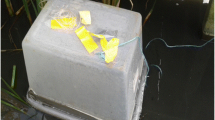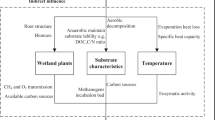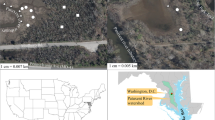Abstract
Wetlands are amongst the most important natural ecosystems on earth. India is blessed to have several multifunctional wetland ecosystems. Apart from their functional significance, wetlands also act as sources or sinks for greenhouse gases (GHGs) depending on their intrinsic factors. Methane (CH4), one of the major GHGs, is emitted from wetlands. The present paper attempts to review the status of Indian wetlands in terms of CH4 emission. Selected studies have been taken into consideration in the present paper to have an idea about the range of fluxes observed in air–water and air–soil interface of Indian wetlands, with special emphasis on the differences between saline and freshwater wetlands. The present study also emphasises important controlling factors such as dissolved oxygen (DO), salinity, sulphate, soil temperature, pH and sediment water content that are responsible for seasonal variations in CH4 flux. Mean air–soil CH4 flux in Indian wetlands ranged between ~ 6 and ~ 526 mg m−2 h−1, whereas air–water methane CH4 fluxes ranged between ~ 3 and ~ 194 mg m−2 h−1.
Similar content being viewed by others
References
Space Applications Centre (SAC) (2011) National Wetland Atlas. SAC, Indian Space Research Organisation, Ahmedabad
Zhang Z, Zimmermann NE, Stenke A, Li X, Hodson EL, Zhu G, Huang C, Poulter B (2017) Emerging role of wetland methane emissions in driving 21st century climate change. Proc Nat Acad Sci. https://doi.org/10.1073/pnas.1618765114
Hu BL, Shen LD, Lian X, Zhu Q, Liu S, Huang Q, He ZF, Geng S, Cheng DQ, Lou LP, Xu XY, Zheng P, He YF (2014) Evidence for nitrite-dependent anaerobic methane oxidation as a previously overlooked microbial methane sink in wetlands. Proc Nat Acad Sci 111:4495–4500
Wuebbles DJ, Hayhoe K (2002) Atmospheric methane and global change. Earth Sci Rev 57:177–210
Cao M, Marshall S, Gregson K (1996) Global carbon exchange and methane emissions from natural wetlands: application of a process-based model. J Geophys Res Atmos 101:14399–14414
Solomon S, Qin D, Manning M, Chen Z, Marquis M, Averyt KB, Tignor M, Miller HL (2007) Contribution of working group I to the fourth assessment report of the intergovernmental panel on climate change. Cambridge University Press, Cambridge, United Kingdom and New York, p 996
Bansal S, Chakraborty M, Katyal D, Garg JK (2015) Assessment of Methane Variability from Natural Wetlands of Uttar Pradesh, India-Implications for Tropical Countries. Res J Environ Sci 9:101
Harriss RC, Sebacher DI, Day FP (1982) Methane flux in the great dismal swamp. Nature 297:673–674
Mitsch WJ, Gooselink JG (2007) Wetlands, 4th edn. Wiley, New York
Keppler F, Rockmann T (2007) Methane plants and climate change. Sci Am 296:52–57
Verma A, Subramanian V, Ramesh R (2002) Methane emissions from a coastal lagoon: Vembanad Lake, West Coast, India. Chemosphere 47:883–889
Purvaja R, Ramesh R (2001) Natural and anthropogenic methane emission from coastal wetlands of South India. Environ Manag 27:547–557
Ramesh R, Purvaja GR, Parashar DC, Gupta PK, Mitra AP (1997) Anthropogenic forcing on methane efflux from polluted wetlands (Adyar River) of Madras City, India. Ambio 26:369–374
Khoiyangbam RS, Ganesh S, Singh G (2007) Evaluation of methane emissions from urban wetlands in Jhansi, Uttar Pradesh. In: Proceedings of the Taal 2007: The 12th World Lake Conference pp. 1114–1121
Khoiyangbam R, Kumar W (2014) Research article Influence of waste disposal on water quality and methane emission from Nambol turel: a feeder stream of Loktak lake in Manipur, India. Int J Recent Sci Res 5:974–979
Singh SN, Kulshreshtha K, Agnihotri S (2000) Seasonal dynamics of methane emission from wetlands. Chemosphere Glob Change Sci 2:39–46
Dutta MK, Chowdhury C, Jana TK, Mukhopadhyay SK (2013) Dynamics and exchange fluxes of methane in the estuarine mangrove environment of the Sundarbans, NE coast of India. Atmos Environ 77:631–639
Khan MA, Zargar MY (2013) Experimental quantification of greenhouse gas (CH4) emissions from fertilizer amended rice field soils of Kashmir Himalayan Valley. J Environ Eng Ecol Sci 2:5
Singh S, Singh JS, Kashyap AK (1999) Methane flux from irrigated rice fields in relation to crop growth and N-fertilization. Soil Biol Biochem 31:1219–1228
Shalini A, Ramesh R, Purvaja R, Barnes J (2006) Spatial and temporal distribution of methane in an extensive shallow estuary, South India. J Earth Syst Sci 115:451–460
Krithika K, Purvaja R, Ramesh R (2008) Fluxes of methane and nitrous oxide from an Indian mangrove. Curr Sci 94:218–224
Kumar JN, Viyol SV (2009) Short-term diurnal and temporal measurement of methane emission in relation to organic carbon, phosphate and sulphate content of two rice fields of central Gujarat, India. Paddy Water Environ 7:11–16
Vijay A, Nandan SB (2017) Carbon dynamics, processes and factors regulating greenhouse gas emissions from wetlands. In: Prusty B, Chandra R, Azeez P (eds) Wetland Science. Springer, New Delhi
Biswas H, Mukhopadhyay SK, Sen S, Jana TK (2007) Spatial and temporal patterns of methane dynamics in the tropical mangrove dominated estuary, NE coast of Bay of Bengal, India. J Mar Syst 68:55–64
Jha CS, Rodda SR, Thumaty KC, Raha AK, Dadhwal VK (2014) Eddy covariance based methane flux in Sundarbans mangroves. India J Earth Syst Sci 123:1089–1096
Chauhan R, Ramanathan AL, Adhya TK (2008) Assessment of methane and nitrous oxide flux from mangroves along Eastern coast of India. Geofluids 8:321–332
Purvaja R, Ramesh R, Frenzel P (2004) Plant-mediated methane emission from an Indian mangrove. Glob Change Biol 10:1825–1834
Sorrell BK, Boon PI (1992) Biogeochemistry of billabong sediments II. Seasonal variations in methane production. Freshw Biol 27:435–445
Neue HU, Roger PA (1993) Rice agriculture: factors controlling emissions. In: Khalil MAK (ed) Atmospheric methane: sources, sinks, and role in global change, vol 13. Springer, Berlin, Heidelberg, pp 254–298
Schütz H, Holzapfel-Pschorn A, Conrad R, Rennenberg H, Seiler W (1989) A 3-year continuous record on the influence of daytime, season, and fertilizer treatment on methane emission rates from an Italian rice paddy. J Geophys Res Atmos 94:16405–16416
Cao M, Gregson K, Marshall S (1998) Global methane emission from wetlands and its sensitivity to climate change. Atmos Environ 32:3293–3299
Garcia JL, Patel BK, Ollivier B (2000) Taxonomic, phylogenetic, and ecological diversity of methanogenic Archaea. Anaerobe 6:205–226
Kumar A, Sharma MP (2012) Greenhouse gas emissions from hydropower reservoirs. Hydro Nepal J Water Energy Environ 11:37–42
Kumar A, Sharma MP (2014) Impact of water quality on GHG emissions from Hydropower Reservoir. J Mater Environ Sci 5:95–100
Suryavanshi P, Singh YV, Prasanna R, Bhatia A, Shivay YS (2013) Pattern of methane emission and water productivity under different methods of rice crop establishment. Paddy Water Environ 11:321–329
Acknowledgements
The first author is indebted to University Grants Commission (UGC), India for funding the UGC National Fellowship. One of the co-authors is grateful to National Remote Sensing Centre, Department of Space, Govt. of India for funding his Research Associate Fellowship.
Author information
Authors and Affiliations
Corresponding author
Ethics declarations
Conflict of interest
The authors declare that they have no conflict of interest to publish this manuscript.
Additional information
Significance statement
Methane gas is an important greenhouse gas which is known to have a deleterious effect on the global climate as it leads to global warming. The present paper concisely reviews the status of the methane emission from the Indian Wetlands.
Rights and permissions
About this article
Cite this article
Shaher, S., Chanda, A., Hazra, S. et al. Status of Methane Emission from Indian Wetlands (Saline vs. Freshwater): A Mini Review. Proc. Natl. Acad. Sci., India, Sect. B Biol. Sci. 89, 1133–1139 (2019). https://doi.org/10.1007/s40011-018-1005-x
Received:
Revised:
Accepted:
Published:
Issue Date:
DOI: https://doi.org/10.1007/s40011-018-1005-x




